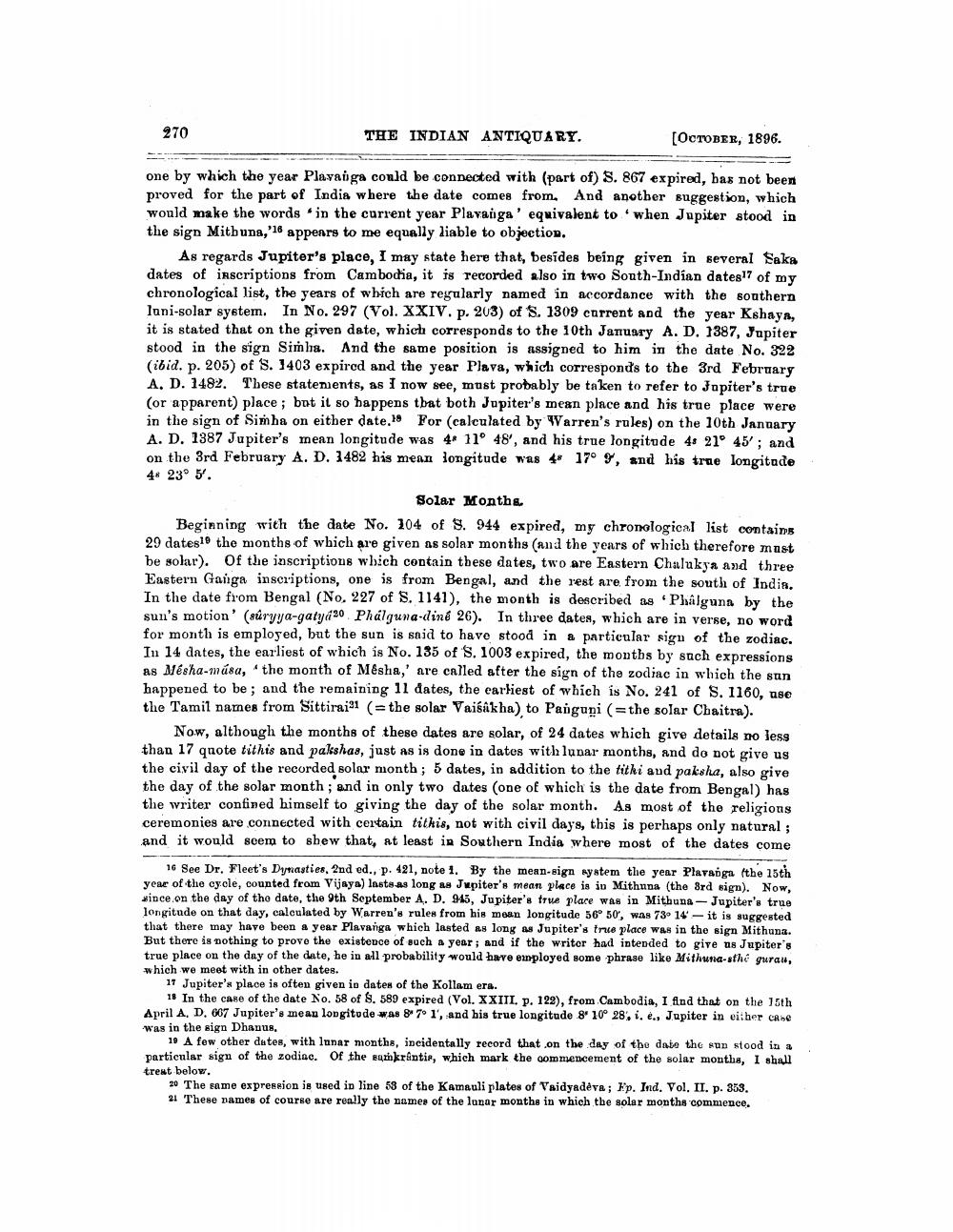________________
270
THE INDIAN ANTIQUARY.
[OCTOBER, 1896.
one by which the year Plavaiga could be connected with (part of) S. 867 expired, bas not been proved for the part of India where the date comes from. And another suggestion, which would make the words in the current year Playanga' equivalent to when Jupiter stood in the sign Mithuna, '18 appears to me equally liable to objection.
As regards Jupiter's place, I may state here that, besides being given in several Saka dates of inscriptions from Cambodia, it is recorded also in two South-Indian dates7 of my chronological list, the years of which are regularly named in accordance with the southern luni-solar system. In No. 297 (Vol. XXIV. p. 203) of S. 1309 current and the year Kshaya, it is stated that on the given date, which corresponds to the 10th January A. D. 1387, Jupiter stood in the sign Simha. And the same position is assigned to him in the date No. 322 (ibid. p. 205) of S. 1403 expired and the year Plava, which corresponds to the 3rd February A. D. 1482. These statements, as I now see, most probably be taken to refer to Japiter's true (or apparent) place; but it so happens that both Jupiter's mean place and his true place were in the sign of Simha on either date. For (calculated by Warren's rules) on the 10th January A. D. 1387 Jupiter's mean longitude was 4* 11° 48', and his true longitude 4. 21° 45'; and on the 3rd February A. D. 3482 his mean longitude was 4. 17° 9, and his true longitude 4* 23° 5.
Solar Months Beginning with the date No. 104 of S. 944 expired, my chronological list contains 29 dates19 the months of which are given as solar months (and the years of which therefore mast be solar). Of the inscriptions which contain these dates, two are Eastern Chalukya and three Eastern Ganga inscriptions, one is from Bengal, and the rest are from the south of India, In the date from Bengal (No. 227 of S. 1141), the month is described as Phålgunn by the sun's motion' (rúryya-gatyá20 Phálguna-diné 26). In three dates, which are in verse, no word for month is employed, but the sun is said to have stood in a particular sign of the zodiac. In 14 dates, the earliest of which is No. 135 of S. 1003 expired, the months by such expressions as Mésha-mása, the month of M&sha,' are called after the sign of the zodiac in which the sun happened to be ; and the remaining 11 dates, the earliest of which is No. 241 of S. 1160, ase the Tamil names from Sittiraia1 (=the solar Vaisakha) to Panguni (=the solar Chaitra).
Now, although the months of these dates are solar, of 24 dates which give details no less than 17 quote tithis and pakshas, just as is done in dates with lunar months, and do not give us the civil day of the recorded solar month; 5 dates, in addition to the titki and paksha, also give the day of the solar month; and in only two dates (one of which is the date from Bengal) has the writer confined himself to giving the day of the solar month. As most of the religions ceremonies are connected with certain titkis, not with civil days, this is perhaps only natural ; and it would seem to shew that, at least in Southern India where most of the dates come
16 See Dr, Fleet's Dynasties, 2nd ed., p. 421, note 1. By the mean-sign system the year Plavanga the 15th year of the cycle, counted from Vijaya) lasts as long as Jupiter's mean place is in Mithuna (the 3rd sign). Now, vince on the day of the date, the 9th September A. D. 945, Jupiter's true place was in Mithune - Jupiter's true longitude on that day, calculated by Warren's rules from his mean longitude 56° 50', was 73° 14 - it is suggested that there may have been a year Plavanga which lasted as long as Jupiter's true place was in the sign Mithuna. But there is nothing to prove the existence of such a year; and if the writor had intended to give us Jupiter's true place on the day of the date, he in all probability would have employed some phrase like Mithuna-sthe gurau, which we meet with in other dates.
17 Jupiter's place is often given in dates of the Kollam era.
18 In the case of the date No. 58 of 8. 589 expired (Vol. XXIII. P. 122), from Cambodia, I find that on the 15th April A. D. 607 Jupiter's mean longitude was 87° 1', and his true longitude 8' 10° 28, i, e., Jupiter in either Cabe was in the sign Dhanus,
19 A few other dates, with lunar months, incidentally record that on the day of the date the fun stood in a particular sign of the zodiac. Of the sankrantir, which mark the commencement of the solar months, I shall trent below
20 The same expression is used in line 53 of the Kamauli plates of Vaidyadeve; Ep. Ind. Vol. II. p. 353. 21 These dames of course are really the names of the lunar months in which the solar months commence.




